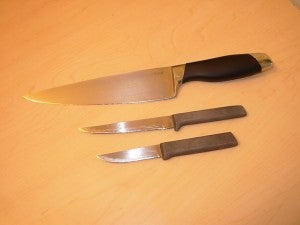How To Sharpen Kitchen Knives
Sharpening your knives is a professional skill easily learned. With a little instruction and practice, you can maintain your kitchen knives in a very sharp state.
There are a vast array of sharpening tools one can use to sharpen knives. Here are some of the more common ones. Manmade stones like diamond hones, ceramic sticks and stones, Norton stones, Japanese water stones, and India stones come in a number of different shapes and sizes. An extremely effective natural one is an Arkansas stone that comes in soft, medium and hard grit.
All sharpening stones come in what are called grits-a measure of the coarseness or smoothness of the stone. Coarser grits are lower numbers, finer grits are higher numbers.
Selecting the grindstone
- The familiar Norton stones that come in two grits, coarse and fine, are okay to get started with, but their ability to produce an ultra sharp edge is extremely limited.
- Japanese water stones are messy because they are used with water as a lubricant, but they are extremely efficient, removing metal quickly and producing an extremely sharp edge.
- India stones are also a good sharpening stone choice as are Arkansas stones, although they work much slower than Japanese water stones.
- India stones, natural Arkansas stones, and Norton stones require a lubricant in use, usually a honing oil.
- Ceramic stones don’t require any kind of lubricant and work very well for maintaining a sharp edge but they are ineffective at building a sharp edge on your knives from scratch.
- Diamond hones, also a lubricant-free sharpening device, are not a stone at all. They are actually a base of some material like nylon impregnated with manmade diamonds. They also do not work especially well for establishing a sharp edge but they excel at maintaining one or just touching up a slightly dull edge.
- You will also want to purchase a tool called a sharpening steel.
The sharpening process
- Select the proper stone or hone and place it on a flat surface, one that will not be damaged by the lubricant you choose.
- Unless your knife is “dull as a hoe”, choose a coarse grit stone and apply some honing oil to the stone’s surface.
- If you are using ceramic stones, Japanese water stones, or a diamond hone you may use water.
- Now place the knife blade flat on the stone surface, at one end of the stone and raise the back of the knife up off the stone about the thickness of a nickel.
- Lock your wrist (the one holding the knife) and pull the knife blade down toward one end of the stone.
- Lift the knife blade up, flip it over so the edge is pointing in the opposite direction, lay it back down on the stone at the same end where you picked it up and repeat the process, this time pushing the knife blade away in the opposite direction.
- Do this slowly and carefully, locking your wrist each time to maintain the correct sharpening angle.
- After a dozen strokes (or several dozen strokes, depending on how dull and neglected your knife is), check the edge and then repeat the same process using a finer grit stone.
The final edge
After you have used the whet stones, use the sharpening steel.
Place its point on a surface such as a cutting board, holding the tool upright.
Place the edge of the blade against the sharpening steel shaft, tilting its non-edge about a nickel thickness away from the shaft and stroke the blade downward toward the cutting board, pulling the knife toward you at the same time.
Now do the same on the other side of the shaft with the other side of the blade, alternating back and forth.
It only takes a few strokes of this to put the final edge on your blade and you are ready for a full day of work in the kitchen. Just use the sharpening steel periodically as you work to maintain that near perfect edge.
Tips
Never test a knife edge with a finger or thumb nail. Try to cut something that the knife is normally used for. If it doesn’t cut like it is supposed to, sharpen it.
Always use the proper lubricant for your sharpening stone. Using it without lubricant will clog the pores and ruin it.
Avoid using a grinding wheel or file to sharpen kitchen knives.
Discuss this and other Home Improvement Topics in our How To Forum





